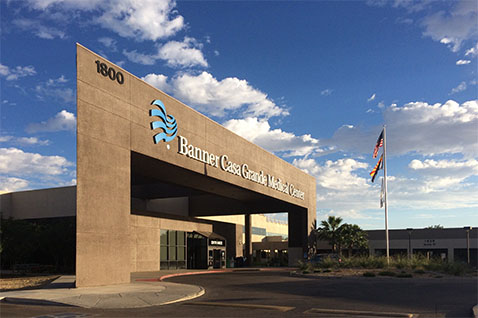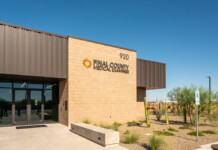
Banner Casa Grande Medical Center saves man driving back to Ohio after suffering a “widow maker” heart attack.
Aug. 8, 43-year-old Wayne Schoenberger was transporting a car back to Ohio when he was pulled over by law enforcement for a window tint violation. Little did he know, that routine stop would save his life.
After the encounter, a flustered Shoenberger pulled off at a truck stop and called his wife. That’s when the heart attack happened. To his fortune, an ambulance was parked just across the street. With little recollection on how he managed to get to the ambulance before collapsing and losing consciousness, he does remember being on the phone with his wife during the short drive to nearby Banner Casa Grande Medical Center (BCGMC).
In its 10 years, the Interventional Cardiology and STEMI program at BCGMC has saved the lives of 461 patients, like Schoenberger, who came to the emergency department while experiencing ST elevated myocardial infarction (STEMI), more commonly known as a heart attack. Thanks to this dedicated, interdisciplinary team, patients have the best chance to return to their normal lives.
The Interventional Cardiology and STEMI program at BCGMC begins in the emergency department, where a patient is stabilized and transferred to the catheterization lab. Imaging is used to diagnose and treat cardiovascular disease, it concludes with recovery and discharge from a nursing unit.
“One unique accomplishment of the BCGMC cath lab is the focus on the radial access approach for patient procedures. Whenever appropriate, the cardiac catheter is inserted through the wrist of the patient rather than the groin, thus decreasing the discomfort as well as the recovery time and risk to the patient. BCGMC is currently utilizing this approach on 87% of patients, well above the current national average. The program has also been recognized nationally for coronary interventional procedures and excellence,” said Cath Lab Director Jessica Maclean.
“When every second counts between life and death, access saves lives. The emergency personnel and healthcare professionals who serve our communities can never be appreciated enough. At Banner, we are so fortunate to have our local and regional partners, modern facilities and equipment, and are proud to make lives better in all of western Pinal County,” said Brian Kellar, CEO of Banner Casa Grande Medical Center.
One of the measures of the quality of an interventional cardiology and STEMI program is the length of time it takes for a patient to have blood restored to the heart when experiencing a heart attack. This is called the “door to balloon time.” The clock begins ticking when the patient enters the emergency department and stops when the cardiac team and physician open the blockage in the coronary arteries, restoring blood flow to the heart.
The gold standard for “door to balloon time” is 90 minutes. This is a critical number because the longer the heart goes without blood flow to the cardiac muscle, the more injury to the heart occurs, resulting in substantial health damages such as heart failure and even death. Schoenberger had a door to balloon time of 37 minutes.
“I am thankful and grateful to the team who worked on me and how well they worked under that type of pressure to save a life. It’s still so unbelievable that I’m alive,” said Schoenberger.













![Alleged car thief released without charges Phoenix police stop a stolen vehicle on April 20, 2024. [Facebook]](https://www.inmaricopa.com/wp-content/uploads/2024/04/IMG_5040-218x150.jpg)



![Maricopa’s ‘TikTok Rizz Party,’ explained One of several flyers for a "TikTok rizz party" is taped to a door in the Maricopa Business Center along Honeycutt Road on April 23, 2024. [Monica D. Spencer]](https://www.inmaricopa.com/wp-content/uploads/2024/04/spencer-042324-tiktok-rizz-party-flyer-web-100x70.jpg)